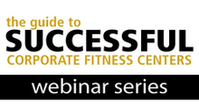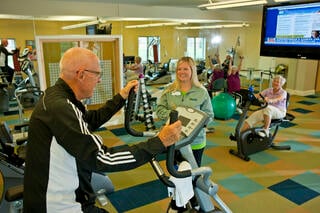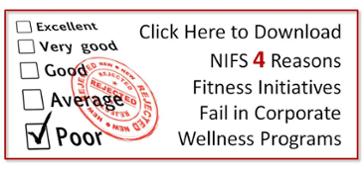 The benefits of providing an onsite corporate fitness center at the workplace are far-reaching and they may or may not have anything to do with reducing health care costs. For leadership, it’s easy to focus on this tangible measurement and lose sight of other reasons to support employees in their health and fitness goals.
The benefits of providing an onsite corporate fitness center at the workplace are far-reaching and they may or may not have anything to do with reducing health care costs. For leadership, it’s easy to focus on this tangible measurement and lose sight of other reasons to support employees in their health and fitness goals.
Learn how one member at a NIFS client location has found value in using her corporate fitness center as she strives to maintain a newly established healthy lifestyle.
Was there an “a-ha” moment or life event that led you to make a positive change for your health?
I’ve known for a number of years that I needed to improve my health, but always had excuses for not doing so. When my granddaughter was born in 2016, I knew I wanted to be around to see her grow up. I also wanted to be able to keep up with her energy so I could be active in her life as she got older. She, and the future grandchildren, have been my inspiration.
What has been a key factor in helping you stick to your new routine? What is your motivation?
Staying motivated is a challenge, so I set a number of small, fun SMART goals that I was determined to achieve. For example, when work sponsored a team to run the Indianapolis Mini Marathon, I decided to run the 5K race. Our NIFS fitness center staff provided a training program to follow. I finished in the top 10% of my age group. I have signed up for five more races, with the next goal being to win my age group.
[Related Content: Why You Might Be Wrong About Outsourcing Fitness Center Management]
How has the fitness center provided a supportive environment for you to work on your health?
There are a number of benefits of having the fitness center onsite. First, it is convenient. Employees can go before work, at lunchtime, or after work; that flexibility is a huge help. I also like the personal attention that is available to help build a structured exercise program that will achieve specific goals. In our corporate fitness center there's a huge variety of activities available, especially the group fitness classes. You can try something new each week.
I really enjoy the supportive atmosphere of the coaches and my coworkers in the center. They make exercise fun. I also feel that we're lucky to have the center as one of our corporate health benefits. The fact that our leadership supports the existence of the center signals that employee health and fitness is important to our organization.
What would you tell your coworkers who still haven't tapped into the benefits of the corporate fitness center?
I spent a long time feeling like I was too tired to put exercise into my schedule. I also told myself that I just did not have the time. But, now that I am exercising regularly and feeling better, I have more energy. I also am more agile and can do things around the house that I have not been able to do in years. It’s funny that one of my excuses in the past for not exercising was thinking I did not have the time or was too busy. Now that I am exercising and have more energy, I get things done faster. So by exercising, I have more time.
***
To read other NIFS "members speak" stories, click here. If your'e looking for a corporate fitness vendor to start improving your employees lives, click here to find out how we support our clients across the US.


 Considering how long it can take to make a global shift in corporate America, the rise of wearable fitness trackers in wellness has been meteoric. A recent study reports an anticipated
Considering how long it can take to make a global shift in corporate America, the rise of wearable fitness trackers in wellness has been meteoric. A recent study reports an anticipated 
 Costs for care, costs for absenteeism, vendor costs, the cost of doing nothing…there has been a lot of chatter and posturing online recently about this information as it relates to corporate wellness. In case you’re not quite up to speed on all the cost-related information, here’s an
Costs for care, costs for absenteeism, vendor costs, the cost of doing nothing…there has been a lot of chatter and posturing online recently about this information as it relates to corporate wellness. In case you’re not quite up to speed on all the cost-related information, here’s an 



 You're senior living community is missing out on some important benefits if you don't have detailed data from your fitness program. Read on to find out what you stand to gain by getting smarter about gathering and using data from resident participation in the fitness center and group exercise classes as well as evaluating resident participation in fitness center appointments and services.
You're senior living community is missing out on some important benefits if you don't have detailed data from your fitness program. Read on to find out what you stand to gain by getting smarter about gathering and using data from resident participation in the fitness center and group exercise classes as well as evaluating resident participation in fitness center appointments and services.
 In truth #1 of this four-part blog, I started to climb on my soapbox about measuring ROI in corporate wellness. (I’ll spare you the rant; you can
In truth #1 of this four-part blog, I started to climb on my soapbox about measuring ROI in corporate wellness. (I’ll spare you the rant; you can 
 In this blog series, we’re focusing on why fitness fails as part of a corporate wellness strategy. The first two truths looked at how
In this blog series, we’re focusing on why fitness fails as part of a corporate wellness strategy. The first two truths looked at how 
 Truth #1: Fitness initiatives fail as part of a corporate wellness strategy because of a lack of programming creativity.
Truth #1: Fitness initiatives fail as part of a corporate wellness strategy because of a lack of programming creativity. 